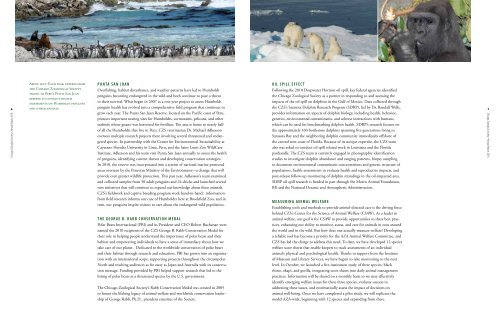Each - beyond words strategic communication
Each - beyond words strategic communication
Each - beyond words strategic communication
Create successful ePaper yourself
Turn your PDF publications into a flip-book with our unique Google optimized e-Paper software.
6<br />
Chicago Zoological Society • Annual Report 2010<br />
Above left: <strong>Each</strong> year, experts from<br />
the Chicago Zoological Society<br />
travel to Peru’s Punta San Juan<br />
reserve to conduct health<br />
assessments on Humboldt penguins<br />
and other animals.<br />
PUNTA SAN JUAN<br />
Overfishing, habitat disturbance, and weather patterns have led to Humboldt<br />
penguins becoming endangered in the wild and both continue to pose a threat<br />
to their survival. What began in 2007 as a one-year project to assess Humboldt<br />
penguin health has evolved into a comprehensive field program that continues to<br />
grow each year. The Punta San Juan Reserve, located on the Pacific coast of Peru,<br />
protects important nesting sites for Humboldts, cormorants, pelicans, and other<br />
seabirds whose guano was harvested for fertilizer. The area is home to nearly half<br />
of all the Humboldts that live in Peru. CZS veterinarian Dr. Michael Adkesson<br />
oversees multiple research projects there involving several threatened and endangered<br />
species. In partnership with the Center for Environmental Sustainability at<br />
Cayetano Heredia University in Lima, Peru, and the Saint Louis Zoo WildCare<br />
Institute, Adkesson and his team visit Punta San Juan annually to assess the health<br />
of penguins, identifying current threats and developing conservation strategies.<br />
In 2010, the reserve was incorporated into a system of national marine protected<br />
areas overseen by the Peruvian Ministry of the Environment—a change that will<br />
provide even greater wildlife protection. This past year, Adkesson’s team examined<br />
and collected samples from 50 adult penguins and 24 chicks and launched several<br />
new initiatives that will continue to expand our knowledge about these animals.<br />
CZS’s fieldwork and captive breeding program work hand-in-hand: information<br />
from field research informs our care of Humboldts here at Brookfield Zoo, and in<br />
turn, our penguins inspire visitors to care about the endangered wild population.<br />
THE GEORGE B. RABB CONSERVATION MEDAL<br />
Polar Bears International (PBI) and its President and CEO Robert Buchanan were<br />
named the 2010 recipients of the CZS George B. Rabb Conservation Medal for<br />
their role in helping people understand the importance of polar bears and their<br />
habitat and empowering individuals to have a sense of immediacy about how we<br />
take care of our planet. Dedicated to the worldwide conservation of polar bears<br />
and their habitat through research and education, PBI has grown into an organization<br />
with an international scope, supporting projects throughout the circumpolar<br />
North and reaching audiences as far away as Japan and Australia with its conservation<br />
message. Funding provided by PBI helped support research that led to the<br />
listing of polar bears as a threatened species by the U.S. government.<br />
The Chicago Zoological Society’s Rabb Conservation Medal was created in 2005<br />
to honor the lifelong legacy of animal welfare and worldwide conservation leadership<br />
of George Rabb, Ph.D., president emeritus of the Society.<br />
OIL SPILL EFFEC T<br />
Following the 2010 Deepwater Horizon oil spill, key federal agencies identified<br />
the Chicago Zoological Society as a partner in responding to and assessing the<br />
impacts of the oil spill on dolphins in the Gulf of Mexico. Data collected through<br />
the CZS’s Sarasota Dolphin Research Program (SDRP), led by Dr. Randall Wells,<br />
provides information on aspects of dolphin biology, including health, behavior,<br />
genetics, environmental contaminants, and adverse interactions with humans,<br />
which can be used for benchmarking dolphin health. SDRP’s research focuses on<br />
the approximately 160 bottlenose dolphins spanning five generations living in<br />
Sarasota Bay and the neighboring dolphin community immediately offshore of<br />
the central west coast of Florida. Because of its unique expertise, the CZS team<br />
also was asked to conduct oil spill related work in Louisiana and the Florida<br />
panhandle. The CZS team is currently engaged in photographic identification<br />
studies to investigate dolphin abundance and ranging patterns, biopsy sampling<br />
to document environmental contaminant concentrations and genetic structure of<br />
populations, health assessments to evaluate health and reproductive impacts, and<br />
post-release follow-up monitoring of dolphin strandings in the oil-impacted area.<br />
SDRP oil spill research is funded in part through the Morris Animal Foundation,<br />
BP, and the National Oceanic and Atmospheric Administration.<br />
MEASURING ANIMAL WELFARE<br />
Establishing tools and methods to provide animal-directed care is the driving force<br />
behind CZS’s Center for the Science of Animal Welfare (CSAW). As a leader in<br />
animal welfare, our goal is for CSAW to provide opportunities to share best practices,<br />
enhancing our ability to monitor, assess, and care for animals in zoos around<br />
the world and in the wild. But how does one actually measure welfare? Developing<br />
a reliable tool has become a priority for the AZA Animal Welfare Committee, and<br />
CZS has led the charge to address this need. To date, we have developed 12 species<br />
welfare score sheets that enable keepers to track assessments of an individual<br />
animal’s physical and psychological health. Thanks to support from the Institute<br />
of Museum and Library Services, we have begun to take monitoring to the next<br />
level. In October, we launched a five-institution study of three species: black<br />
rhino, okapi, and gorilla, integrating score sheets into daily animal management<br />
practices. Information will be shared on a monthly basis so we may effectively<br />
identify emerging welfare issues for these three species, evaluate success in<br />
addressing these issues, and systematically assess the impact of decisions on<br />
animal well-being. Once we have completed a pilot study, we will replicate the<br />
model AZA-wide, beginning with 12 species and expanding from there.<br />
7<br />
Chicago Zoological Society • Annual Report 2010



